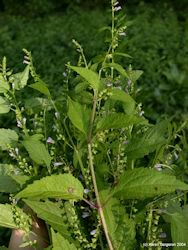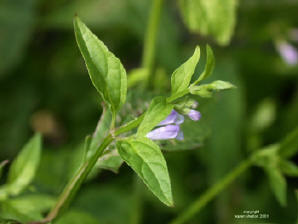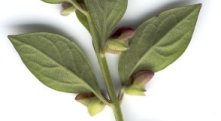Skullcap
Scutellaria lateriflora

Skullcap Herbal Use
Skullcap is used in herbalism for the treatment of a wide range of nervous conditions including epilepsy, insomnia, hysteria, anxiety, delirium tremors, withdrawal from barbiturates and tranquilizers. The infusion is given for nervous headaches, neuralgia and in headache arising from incessant coughing, pain, and inducing sleep when necessary, without any unpleasant symptoms following. Skullcap herb is currently being used as an alternative medicine to treat ADD and a number of nerve disorders.
Skullcap herbal properties include : anti-inflammatory, antispasmodic, slightly astringent, emmenagogue, febrifuge, nervine, sedative and strongly tonic. Some valuable constituents found in the plant are Scutellarin, Catalpol, other Volatile oils, bitter iridoids and Tannins. Scientific studies are proving Skullcap to be a valuable plant in many areas for mental disorders.
A herbal infusion of Skullcap herb is used to promote menstruation. It should not be given to pregnant women since it can induce a miscarriage. An infusion of Skullcap is also used in the treatment of throat infections.
Cautions - Skullcap should be used with some caution since in overdose it causes giddiness, stupor, confusion and twitching. Skullcap has been linked to liver damage, though it is suspected that the source of damage was actually from Germander being substituted for Skullcap. Use in moderation and avoid if you have liver problems.
 Photo Copyright Karen Bergeron 2003
Photo Copyright Karen Bergeron 2003
Skullcap Habitat
Skullcap is a native North American perennial herb, found from New York to West Virginia and southward to South Carolina, Alabama and Missouri. Growing in rich woods, thickets, bluffs and along roadsides in wet ditches. Scutellaria lateriflora, the skullcap that is most used in herbal medicine, prefers a moist shady environment. Other species of Skullcap can be found in habitats ranging from deep woods to as sunny meadows.
Skullcap Plant Description
Skullcap root is a creeping short rhizome, which sends up hairy, square stems, 6 to 18 inches high, branched, or, in small specimens, nearly simple, with opposite leaves, heart-shaped at the base, 1/2 to 2 1/2 inches long, scalloped or toothed edges. The blue to lavender flowers are in racemes and grow from the leaf axils of the upper plant. They are hooded, tube shaped, and two lipped the upper lip being the hood and the lower lip having two shallow lobes. Scutellaria lateriflora is a weak stemmed plant that often lops over and forms new roots where it touches the ground. Other Skullcaps are more upright. Purple flowers bloom from May to August. All Skullcaps have this unique seed pod and distinctive hooded flowers. Skullcap leaf size and shapes vary widely amongst the species. Color of flowers range from red-violet to blue-violet often with white markings. 
Laterifolia is the species most often used by herbalists, Its flowers are small and leaves triangular. However, you can use any species of Skullcap for herbal teas and tinctures.
How to Grow Skullcap
Skullcap is easy in a part shade position and any ordinary garden soil. Sow seed in early spring after danger of frost is past.
Skullcap History and Folklore
Skullcap herb was well known among the Cherokee and other Native American tribes, as a strong emmenagogue and female herbal remedy. It was used in some tribes as a ceremonial plant to introduce young girls into womanhood. It was once believed that Skullcap was useful in the treatment of rabies and schizophrenia. Skullcap was also used to induce visions.
How to Harvest and Use Skullcap Herb
Gather above ground parts of Skullcap herb, in the summer as flowers bloom, dry and store for later herbal use or use fresh herb to make tincture.
Skullcap Herbal Recipe
Herbal tea: To 1 oz. of the powdered herb add a pint of boiling water, steep 10 min. give in 1/2 teacup doses, every few hours.
Article by Deb Jackson & Karen Bergeron



